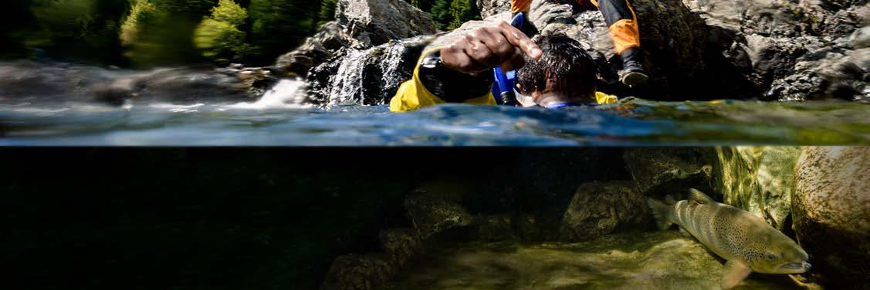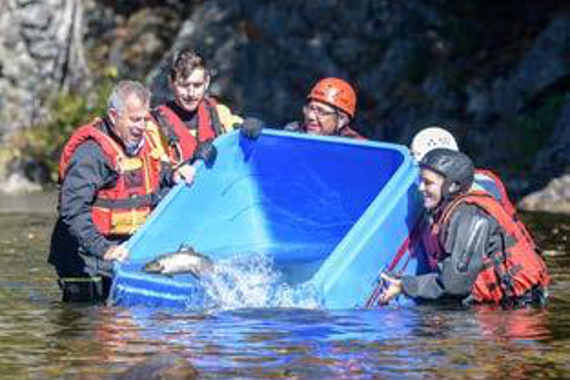
Park visitors help monitor Inner Bay of Fundy salmon restoration during the Swim with Salmon program. Photo: © Nigel Fearon Photography
Action under water
Bringing wild salmon back to Fundy National ParkFootnote *
What’s the issue?
 Hatchery-reared wild salmon being released into the Upper Salmon River in October 2017. Photo: © Nigel Fearon Photography
Hatchery-reared wild salmon being released into the Upper Salmon River in October 2017. Photo: © Nigel Fearon PhotographyInner Bay of Fundy Atlantic salmon are critically endangered across their range, including in Fundy National Park. Their troubles began with historic overfishing at sea and were then compounded when freshwater habitats were degraded. At their peak in the mid-1960s, 40,000 adults returned to spawn within the 40 or so rivers of the inner bay; by 2003, less than 200 made the return trip. Because they are an important source of food and culture for Indigenous peoples, there’s an added urgency to save this iconic species. Through collaboration with Indigenous partners, industry and local communities, Fundy National Park is determined to apply innovative methods to help restore the Inner Bay of Fundy Atlantic salmon.
What’s our approach?
- Work in partnership with Fort Folly First Nation and industrial partners to rear large numbers of adult salmon in sea cages for wild release.
- Study the fitness of released salmon that have spent limited time in captivity.
- Release high numbers of adult native salmon to spawn naturally so their offspring are produced and mature entirely in the wild.
- Monitor the production of wild-hatched offspring and the number of returning salmon to evaluate the overall effectiveness of our approach for population restoration.
- With academic partners, conduct research to better understand how restoration is affecting multiple levels of the food chain – from nutrients to top predators.
What’s been accomplished?
- Partnered with aquaculture industry and established the first wild Atlantic salmon conservation farm, using live gene bank specimens to safeguard this unique population.
- In 2016, released 844 native adult salmon into the Upper Salmon River.
- In 2017, detected juvenile, wild-born salmon throughout the Upper Salmon River, making it the only river in the population range fully occupied with wild-hatched juvenile salmon!
- Garnered major media coverage, including a TV Ontario documentary (800,000 viewers), a Toronto Star travel feature, and a Canadian Geographic article; published multiple scientific articles documenting efforts and evidence of success.
- Began popular Swim with the Salmon program, which invites visitors to engage in recovery monitoring of the iconic species.
- Date modified :